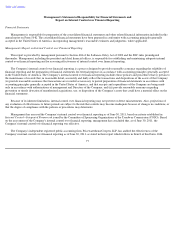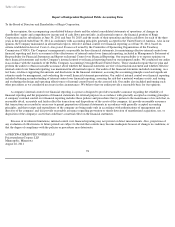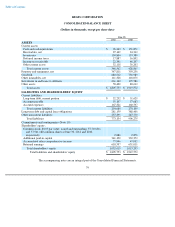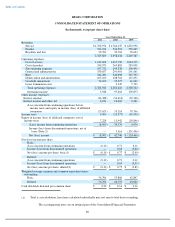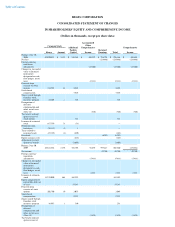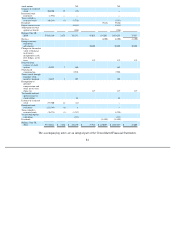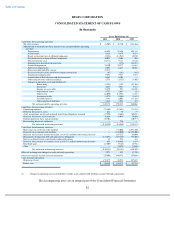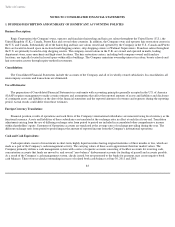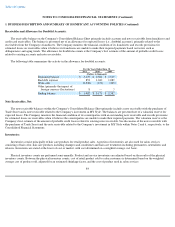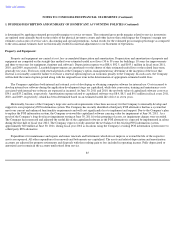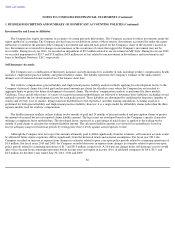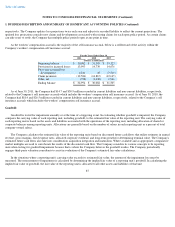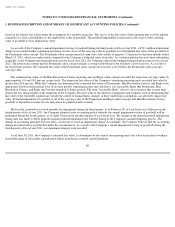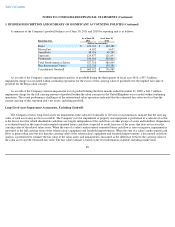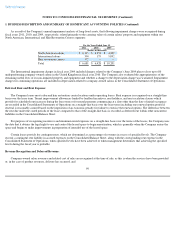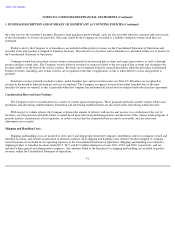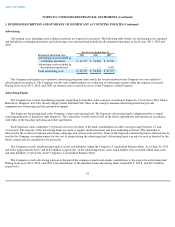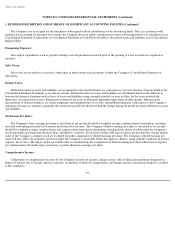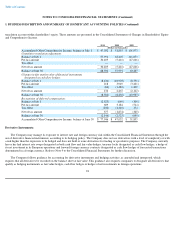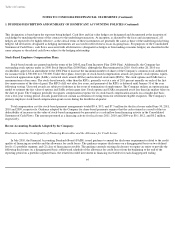Supercuts 2011 Annual Report Download - page 90
Download and view the complete annual report
Please find page 90 of the 2011 Supercuts annual report below. You can navigate through the pages in the report by either clicking on the pages listed below, or by using the keyword search tool below to find specific information within the annual report.
Table of Contents
NOTES TO CONSOLIDATED FINANCIAL STATEMENTS (Continued)
1. BUSINESS DESCRIPTION AND SUMMARY OF SIGNIFICANT ACCOUNTING POLICIES (Continued)
Investment In and Loans to Affiliates:
The Company has equity investments in securities of certain privately held entities. The Company accounts for these investments under the
equity method of accounting. The Company also has loans receivable from certain of these entities. Investments accounted for under the equity
method are recorded at the amount of the Company's investment and adjusted each period for the Company's share of the investee's income or
loss. Investments are reviewed for changes in circumstance or the occurrence of events that suggest the Company's investment may not be
recoverable. During fiscal year 2011, we recorded an impairment of $9.2 million related to our investment in MY Style. During fiscal year 2009,
we recorded impairments of $25.7 and $7.8 million ($4.8 million net of tax) related to our investment in Provalliance and investment in and
loans to Intelligent Nutrients, LLC, respectively.
Self Insurance Accruals:
The Company uses a combination of third party insurance and self-insurance for a number of risks including workers' compensation, health
insurance, employment practice liability and general liability claims. The liability represents the Company's estimate of the undiscounted
ultimate cost of uninsured claims incurred as of the balance sheet date.
The workers' compensation, general liability and employment practice liability analysis includes applying loss development factors to the
Company's historical claims data (total paid and incurred amounts per claim) for all policy years where the Company has not reached its
aggregate limits to project the future development of incurred claims. The workers' compensation analysis is performed for three models;
California, Texas and all other states. A variety of accepted actuarial methodologies are followed to determine these liabilities, including several
methods to predict the loss development factors for each policy period. These liabilities are determined by modeling the frequency (number of
claims) and severity (cost of claims), fitting statistical distributions to the experience, and then running simulations. A similar analysis is
performed for both general liability and employment practices liability; however, it is a single model for all liability claims rather than the three
separate models used for workers' compensation.
The health insurance analysis utilizes trailing twelve months of paid and 24 months of incurred medical and prescription claims to project
the amount of incurred but not yet reported claims liability amount. The lag factors are developed based on the Company's specific claim data
utilizing a completion factor methodology. The developed factor, expressed as a percentage of paid claims, is applied to the trailing twelve
months of paid claims to calculate the estimated liability amount. The calculated liability amount is reviewed for reasonableness based on
reserve adequacy ranges for historical periods by testing prior reserve levels against actual expenses to date.
Although the Company does not expect the amounts ultimately paid to differ significantly from the estimates, self insurance accruals could
be affected if future claims experience differs significantly from the historical trends and actuarial assumptions. For fiscal year 2011, the
Company recorded an increase in expense from changes in estimates related to prior year open policy periods related to continuing operations of
$1.4 million. For fiscal years 2010 and 2009, the Company recorded decreases in expense from changes in estimates related to prior year open
policy periods related to continuing operations of $1.7 and $9.9 million, respectively. A 10.0 percent change in the self-insurance reserve would
affect (loss) income from continuing operations before income taxes and equity in income (loss) of affiliated companies by $4.6, $4.5, and
$4.0 million for the three years ended June 30, 2011, 2010 and 2009,
86


